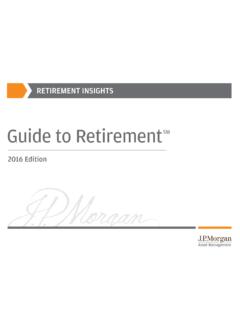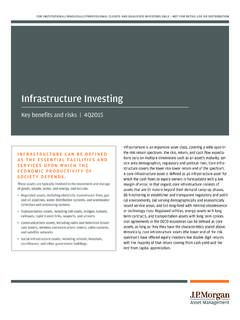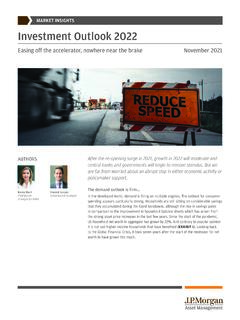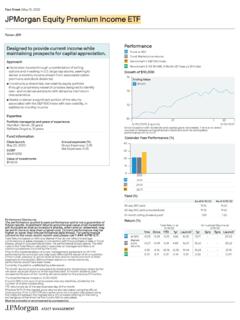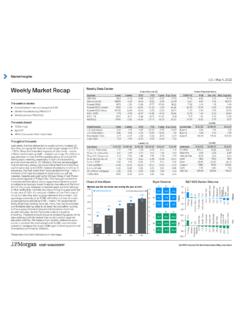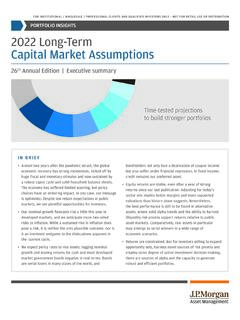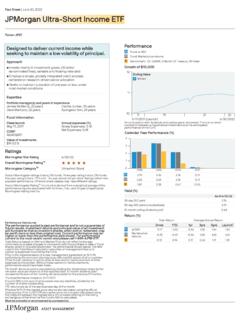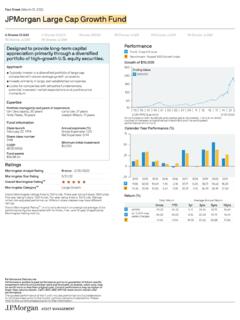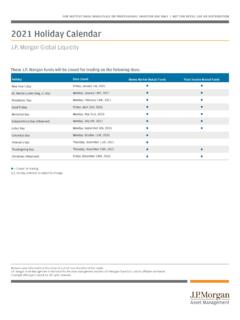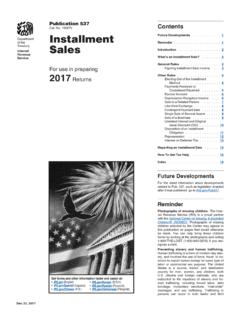Transcription of TRANSACTION COSTS EXPLAINED - am.jpmorgan.com
1 TRANSACTION COSTS EXPLAINEDG etting to grips with charging disclosure under MiFID II and PRIIPsFOR PROFESSIONAL CLIENTS/QUALIFIED INVESTORS/PRESS USE ONLY NOT FOR RETAIL USE OR DISTRIBUTIONTRANSACTION COSTS MORGAN ASSET MANAGEMENT | 3 MYTH 1 TRANSACTION COSTS are a new costThe TRANSACTION COSTS disclosed under MiFID II are NOT a new additional cost. They have always been involved in managing a fund and are already fully reflected in net returns. However, this is the first time they have had to be fully disclosed and expressed in percentage and monetary IIStands for the second Market in Financial Instruments Directive. It is an EU-wide piece of financial regulation designed to offer greater protection for investors and introduce more transparency across financial markets, improve orderly trading behaviour within markets and make the COSTS of trading and investing more regulationEU-wide rules governing information disclosure for all Packaged Retail and Insurance-based Investment Products (PRIIPs).
2 Essentially, this covers any investment product used by a retail consumer that isn t a UCITS pieces of EU legislation that came into force at the start of 2018 the second Market in Financial Instruments Directive (MiFID II) and the Packaged Retail and Insurance-based Investment Products (PRIIPs) regulation seek, among other aims, to make the cost of investing in products such as investment funds completely transparent and comparable. Together, they require the disclosure of all COSTS and charges involved in investing in an investment , this means that for the first time the TRANSACTION COSTS involved in buying and selling the underlying securities inside a fund must be disclosed. In this guide, we want to explain what that means in practice and both the challenges and potential benefits that disclosure of TRANSACTION COSTS 2 Low TRANSACTION COSTS indicate a better investor outcomeAssessing the outcome from investing in a fund requires looking at its performance net of charges.
3 A fund that trades infrequently may have low TRANSACTION COSTS but its strategy may be focused on achieving only modest returns. However, another fund with a more active trading strategy may incur higher TRANSACTION COSTS in order to generate higher long-term returns. TRANSACTION COSTS (and other charges) must always be considered in the context of a fund s strategy and the return being 3 Disclosing TRANSACTION COSTS makes competitor comparisons easierDisclosing TRANSACTION COSTS may encourage fund managers to see how they can reduce the cost of trading, which is to be welcomed. But the very different basis on which COSTS can currently be calculated can be misleading and confusing for investors and may actually serve to make fund comparisons COSTS EXPLAINED4 | MORGAN ASSET MORGAN ASSET MANAGEMENT | 5 What COSTS does a fund need to disclose?
4 There are four types of cost that must now be disclosed separately on an investment fund, both before a fund is sold to an investor and on an ongoing annual basis:One-off chargesPaid when entering or exiting an investment Initial charges Front-loaded management fees Distribution fees Exit fees on redemptionOngoing chargesTaken annually for managing the fund Annual management charge (AMC) Operating and administration (O&A) COSTS custody, trading, reporting COSTS Stock lending COSTS In a fund of funds, the COSTS of the underlying fundsTransaction costsIncurred when trading underlying investments Explicit COSTS of trading underlying investments in a fund Implicit COSTS of trading underlying investments in a fund (see below)
5 TRANSACTION COSTS must take into account two types of costExplicit TRANSACTION COSTS Broker commission - to buy and sell securities Research commission - where the asset manager passes these on to the investor* Taxes and levies - such as stamp duty, regulatory and exchange levies Securities lending - the cost of borrowing or the admin fee from lending for short selling activitiesImplicit TRANSACTION COSTS Arrival cost - the difference between the price at which an asset is valued immediately before an order (the arrival price) and the price at which it is actually traded (the execution price)..minus any value obtained from any swing pricing that may occur* Morgan Asset Management does not pass these COSTS on to the investorIncidental costsAd-hoc charges Performance feesSwing PricingA mechanism used to protect long-term investors in a fund from having the value of their investment eroded by the COSTS involved in managing short-term fund inflows and outflows especially during times of extreme market volatility.
6 If a fund experiences unusually high inflows or outflows, the buying or selling price will be systematically adjusted up or down to absorb the impact of higher-than-usual TRANSACTION see relevant Prospectus for more information on Swing Pricing also referred to as Dilution COSTS EXPLAINED6 | MORGAN ASSET MORGAN ASSET MANAGEMENT | 7 How must COSTS be disclosed? COSTS must be disclosed before a sale and then reported to the investor annually, based on the investor s own level of is the arrival cost calculated?There are a number of ways of calculating TRANSACTION COSTS . The method used by Morgan Asset Management and others to determine implicit TRANSACTION COSTS is the full PRIIPs method, also known as the arrival price document Indicative cost figures must Be based on the amount to be invested by the investor Show the four types of cost separately (see pages 4 and 5) Provide COSTS both in monetary terms and as a percentageAnnual reporting Actual cost figures must Be based on the client s average AUM over the previous 12-month period Show the four types of cost separately (see pages 4 and 5)
7 Provide COSTS both in monetary terms and as a percentage Be based on all holdings not just investments made from 2018 What can create the differential between the arrival price and execution price?A difference between the price at which an order to trade is given and the price at which it is executed can result for a number of reasons: Opportunity cost - Sometimes it is not possible to execute a large trade in one go. Executing a trade in stages can create gains or losses depending on how the market price of the security moves. Trade impact - Instructing a large trade can have the effect of moving the security s price up (if buying) or down (if selling). Managing this impact is a key skill for asset managers and their trading desks.
8 Delay impact - If a TRANSACTION is delayed, for whatever reason even by a minute or so market movements in the meantime can contribute to the arrival cost. Powerful trading systems that minimise latency (the delay between a trading request and response) are vital. 1 The arrival price is the mid-price of the security at the exact time the trade is sent to the broker. 2 The execution price is the price achieved for the whole trade (or the average price achieved where the trade has been broken down into multiple parts). 3 The arrival cost is the difference between the average execution price and the arrival price, expressed as a the buy example shown above, the execution price is 101p and the arrival price is 100p, so the arrival cost is 1%.
9 THE ARRIVAL PRICE METHODOLOGY For illustration purposes priceachieved @101 Arrival cost is101 100 = 1%100 Manager initiatesbuy order @100123 TRANSACTION COSTS EXPLAINED8 | MORGAN ASSET MORGAN ASSET MANAGEMENT | 9Do low TRANSACTION COSTS indicate the best investor outcome?It can be easy to assume that the most attractive funds are those with the lowest TRANSACTION COSTS . But an example of three different managers reacting to news on the same stock shows that s not necessarily the study: Putting TRANSACTION COSTS in contextThree managers react to some negative news in a stock price: Manager 1 sells on the day of the bad news, achieving an execution price of 100, but accumulating an arrival cost of Three days after the newsflow, Manager 2 decides to follow suit and sells.
10 They start their order with the price at 99, and ends up with an execution price of Lastly, Manager 3 takes the longest time to decide, enters the sell order on Day 8 once the price has fallen to 98, and achieves an execution price of all three managers coming to the same conclusion to sell, and each taking one day to execute their order, the manager who achieved the highest selling price, Manager 1, is considered to have the highest TRANSACTION COSTS . Indeed, under the above scenario, Manager 3 would show negative TRANSACTION COSTS , but would have achieved the worst outcome for 1 Manager 2 Manager 3 Order start dateDay 1 Day 4 Day 8 Arrival price1059998 Days to execute111 Execution Worst outcomeArrival Lowest TRANSACTION costShare Price106105104103102101100999897 Day 1 Day 2 Day 3 Day 4 Day 5 Day 6 Day 7 Day 8 Day 9 Day 10 Day 11 Day 12 Manager 1initiates sellorder @105 Manager 2initiates sellorder @99 Manager 3initiates sellorder @98 Manager 3average priceachieved 1average priceachieved @100 Manager 2average priceachieved 1 Arrival cost is105 100 = 2 Arrival cost is99 = 3 Arrival cost is98 = do some funds show a negative or zero TRANSACTION cost?
![MI-GTM 1Q17.pptx [Read-Only] - J.P. Morgan Asset …](/cache/preview/a/8/0/5/a/4/9/7/thumb-a805a4972c28a64389d8b5cdc3a7a25a.jpg)
